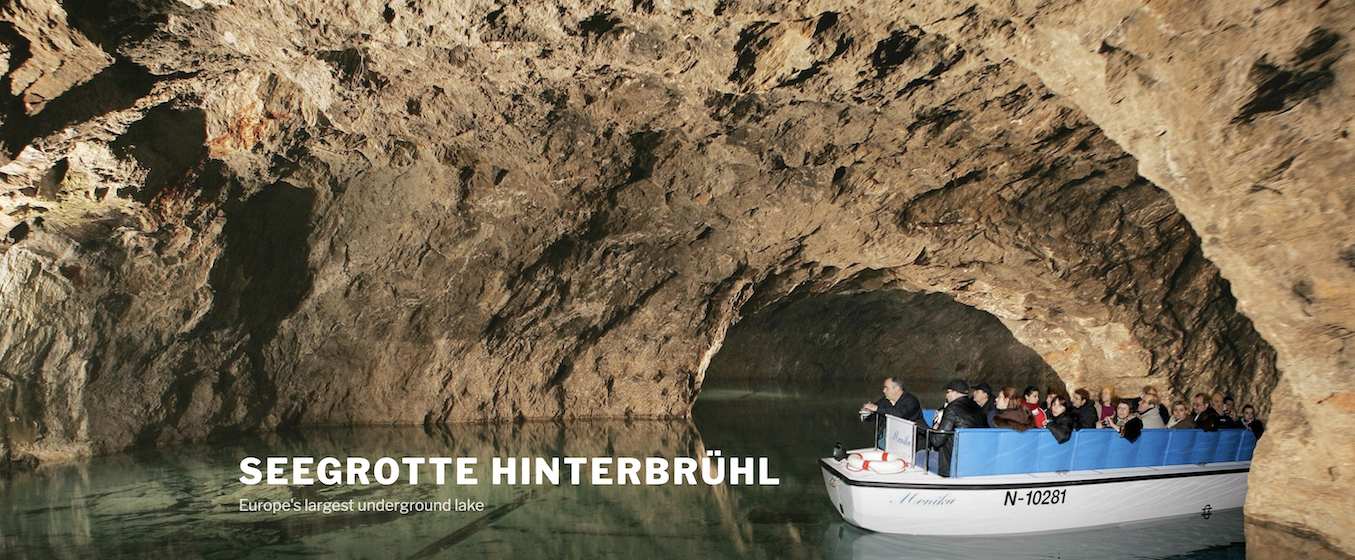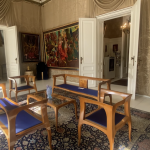Seegrotte Hinterbrühl, Europe’s Largest Underground Lake, is located in the Hinterbrühl region of the Vienna Woods. 30 km from the center of Vienna is the Seegrotte, a cave with the largest underground lake in Europe. The underground lake is a former gypsum mine on three levels. Grey and red gypsum was mined here as agricultural fertilizer from 1848 to 1912.
In 1912 a large water penetration took place, and 20,000,00 liters flooded the mine’s lowest level, and the mine was then shut down. In 1932 it was reopened as a display mine for tourists. The Förderstollen (conveying tunnel) leads visitors 450 meters into the mine, where we see the Rastkammer of the miners. Here they had their meals. This is the warmest gallery of the mine -12C the temperature in all the other galleries is, in both summer and winter, 9 C.
Further down the entrance tunnel, visitors pass the Pferdestall (horse stable). The horses turned the hoisting apparatus and drew the load carts out of the mine. They worked up to 20 years here and, in time, went blind in the darkness. A few steps later, visitors see the little blue lake in an enchanting light.
Passing the steps down to the large lake, which lies 14 meters deeper, visitors see the gallery that is the Bergwerkskapelle (Mine Chapel). Constructed by the miners in 1862, the chapel was dedicated to their patron Saint, Barbara, and to the memory of their comrades who had met with fatal accidents. Here, celebrations in honor of the miner’s patron saint take place from time to time members of the church and large choirs participate on such occasions. The Cardinal of Vienna and the Wienerwald Boys-choir have celebrated a mass here 45 meters under the earth. 3,000 people were present, and Barbara and Friedrichshalle were illuminated entirely by candlelight.
We come now to the Friedrichshalle. On the other side of the Schleppschacht (hauling shaft), visitors visit the largest underground lake in Europe. It lies 60 meters below the surface, has an area of 6,200 m, and measures 12 meters at its deepest point. The boat channel is, however, only 1.20 meters deep.
During World War Two, the water was pumped out of the lake and kept dry by constant pumping. The mine was heated by warm air. Through the efforts of the Heinkel Flugzeugwerke, a German aircraft manufacturing company, an underground airplane factory was established in this mine in 1944. 2,000 workers, among whom were many concentration camp prisoners, constructed the first jet fighter here, the HH162. The plant was bombed in 1944 but without underground damage. In 1945 the German armed forces demolished and blown up factory installations.
Electric motors power the visitor boats. They glide smoothly and soundlessly over the water, and the magnificent perspectives, strings of lights on the rock walls, and beautiful reflections in the water. To avoid the mine flooding, water must be pumped out every night. The lake has, at present, seven springs which bring in approximately 60,000 liters of water per day, but there is no natural outflow.
Featured in the video is Kinley Wesely, Tour Guide talking about Europe’s Largest Underground Lake
Seegrotte Hinterbrühl
Grutschgasse 2a
2371 Hinterbrühl
Austria
Telefon: +43 2236 26364
email office@seegrotte.at
Website: http://seegrotte.at/en/mystische-erlebnisse-english
Filming equipment used by Unravel Travel TV in the recording of this video included a DJI Osmo Mobile 6 Gimbal Stabilizer for Smartphones



